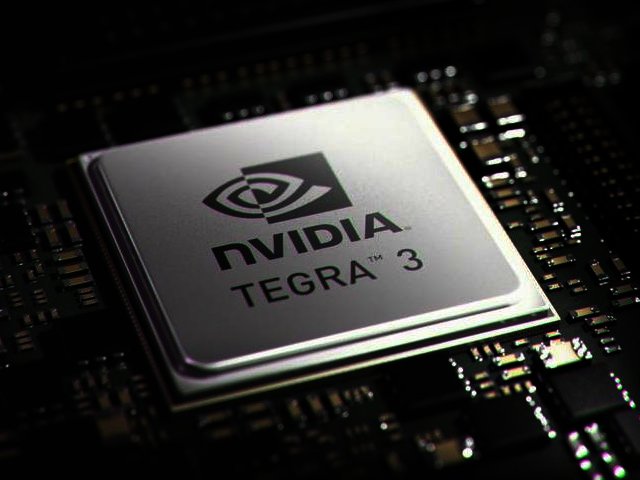PREVIOUS ARTICLENEXT ARTICLE
NEWS

Nvidia makes quad-core Tegra 3 chip official
By Hanleigh Daniels 9 November 2011 | Categories: news
Nvidia has officially introduced its Tegra 3 mobile processor, which it says will bring PC-class performance levels, better battery life as well as improved mobile experiences to tablets and smartphones.
Previously known by the codename Project Kal-El, the Tegra 3 processor provides up to three times the graphics performance of Tegra 2 and up to 61% lower power consumption. According to Nvidia, this will translate into an industry-leading 12 hours of battery life for HD video playback.
The Tegra 3 processor implements a new patent-pending technology known as Variable Symmetric Multiprocessing (vSMP). vSMP includes a fifth CPU companion core, specifically designed for work requiring little power. The four main cores are designed for tasks requiring high performance, the likes of playing games, and generally consume less power than dual-core processors.
Whilst the device that the Tegra 3 is powering is performing tasks that require less power consumption like playing back video or updating background data, the Tegra 3 processor completely shuts down its four performance-tuned cores and makes use of its companion core. For high-performance tasks including web browsing, games and multitasking, the Tegra 3 processor disables the companion and employs its performance cores.
Graphics are handled via the Tegra 3’s new 12-core Nvidia GeForce GPU, which delivers more realism with dynamic lighting, physical effects and high resolution environments, and also supports stereoscopic 3D.
Nvidia stated that the Tegra 3 processor delivers an “experience comparable to that of a game console”, offering full game-controller support, enabling users to play games on their tablet or smartphone, or connect their mobile device to their HDTVs or 3D monitor.
According to Nvidia the Tegra 3 system-on-chip (SoC) provides:
Previously known by the codename Project Kal-El, the Tegra 3 processor provides up to three times the graphics performance of Tegra 2 and up to 61% lower power consumption. According to Nvidia, this will translate into an industry-leading 12 hours of battery life for HD video playback.
The Tegra 3 processor implements a new patent-pending technology known as Variable Symmetric Multiprocessing (vSMP). vSMP includes a fifth CPU companion core, specifically designed for work requiring little power. The four main cores are designed for tasks requiring high performance, the likes of playing games, and generally consume less power than dual-core processors.
Whilst the device that the Tegra 3 is powering is performing tasks that require less power consumption like playing back video or updating background data, the Tegra 3 processor completely shuts down its four performance-tuned cores and makes use of its companion core. For high-performance tasks including web browsing, games and multitasking, the Tegra 3 processor disables the companion and employs its performance cores.
Graphics are handled via the Tegra 3’s new 12-core Nvidia GeForce GPU, which delivers more realism with dynamic lighting, physical effects and high resolution environments, and also supports stereoscopic 3D.
Nvidia stated that the Tegra 3 processor delivers an “experience comparable to that of a game console”, offering full game-controller support, enabling users to play games on their tablet or smartphone, or connect their mobile device to their HDTVs or 3D monitor.
According to Nvidia the Tegra 3 system-on-chip (SoC) provides:
- Fastest web experience with accelerated Adobe Flash Player 11, HTML5 and WebGL browsing, as well as an optimised Javascript engine.
- Fastest applications with speedy performance for multimedia apps, such as photo and video editing.
- Fastest multitasking for switching between common uses, the likes of playing music and games, as well as background tasks.
- Fastest, highest-quality gaming including new Tegra 3 processor-optimised Nvidia Tegra Zone app games such as Shadowgun.
- The world’s first quad-core ARM Cortex A9 CPU.
- New patent-pending vSMP technology, including a fifth CPU core that runs at a lower frequency and operates at exceptionally low power.
- 12-core GeForce GPU, with three times the graphics performance of the Tegra 2 processor, including support for stereoscopic 3D.
- New video engines with support for full HD (1080p) high profile video at 40 Mbps.
- Up to three times higher memory bandwidth.
- Up to two times faster Image Signal Processor.
- 40 games are expected to be available by the end of 2011 and more than 15 Tegra 3 games are under development for Tegra Zone, which is Nvidia’s free Android Market app that showcases the best games optimised for the Tegra processor.
In related news Nvidia also recently introduced its new 3D Vision line of products, which the company says will deliver greater realism and immersion within 3D games, movies as well as photos.
USER COMMENTS
Most Read Articles
Read

Magazine Online
TechSmart.co.za is South Africa's leading magazine for tech product reviews, tech news, videos, tech specs and gadgets.
Start reading now >
Download latest issue
Have Your Say
What new tech or developments are you most anticipating this year?
New smartphone announcements (44 votes)
Technological breakthroughs (29 votes)
Launch of new consoles, or notebooks (14 votes)
Innovative Artificial Intelligence solutions (29 votes)
Biotechnology or medical advancements (24 votes)
Better business applications (160 votes)



